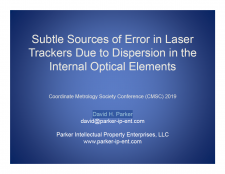
|
Download Members: $0.00 Non‑Members: $75.00 |
Buy Now |
Publication Details
| Published Date: | |
|---|---|
| Download Format: | |
| Citation: | David H. Parker |
Abstract
The speed of light depends on the index of refraction of the medium in which the light is propagating. In a dispersive medium, the speed of an amplitude modulated wavefront depends on the group refractive index, i.e., slightly slower than the carrier light. Corrections for the group refractive index in air are typically made for temperature, humidity, and pressure—without which measurements could be in error by tens of parts per million. The internal instrument optical elements are also subject to dispersive effects, which have heretofore been ignored in the literature—and presumably in the design. The net phase of the modulated waverfont, as received by a detector at the focal point, is dependent on the beam geometry—which most likely depends on distance, due to divergence of the beam. At close range, the majority of the received beam passes through the center of the lens, due to the small beam size. At long range, the received beam passes through the entire lens, due to the expanded beam filling the lens. This source of error can be misinterpreted as being due to distance or power level, when in fact it is the optical design. Spherical, or cat’s eye, retroreflectors are also subject to the same source of error. A simple test to measure the errors is proposed.





